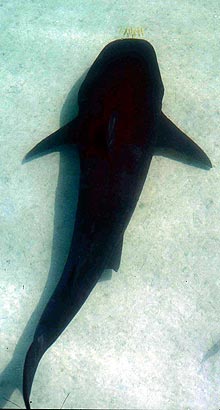
Research Projects – Context Dependence of Predator Risk Effects

Seascape Variation and Context Dependence of Tiger Shark Risk Effects

shallow habitats and cross through the middle
of relatively narrow banks. Do they always
prefer shallow habitats? Might they avoid
large expanses of shallows? If so, this might
make some shallow habitats safe for dugongs,
sea turtles, and other tiger shark prey while
other habitats are dangerous. Therefore,
understanding how the extent and shape of
habitats affect tiger shark habitat use and
decisions by their prey is important for
predicting the effects of tiger shark presence
on the communities of Shark Bay.
Our studies offshore of Monkey Mia have shown that tiger sharks prefer to cruise shallow seagrass beds relative to the deeper water channels. As a result, their prey tend to avoid these habitats and don't make full use of the abundant resources available over the seagrass beds. But are shallow waters always the most dangerous for prey? Do tiger sharks avoid some shallow areas while preferring others even if the depths are the same? These are important questions if we are to extrapolate our results in Shark Bay to other areas, like the Caribbean, where tiger sharks have declined and many of their prey species, including green turtles, now forage largely free from risk.
SBERP is now beginning to investigate how variation in the configuration of the subsurface landscape (the "seascape") influences the habitat use of tiger sharks and, in turn, habitat use by their prey. To do this we have selected two other sites within 30km (20 miles) of our current study site to conduct studies of the abundance and habitat use of tiger sharks, dugongs, sea turtles, sea snakes, and cormorants. One of these sites has much narrower banks than in the main study site. In contrast, the second new site has very large expanses of shallow water and sharks may be less likely to move into the middle of these banks because of an increase in the risk of stranding at very low tides. Therefore, it may be that dugongs and dolphins will prefer to spend their time foraging in the middle of banks (unlike in our main study site) and patterns of tiger shark indirect effects in bank middles and edges will be the opposite of those in the main study area.
This study, together with those of escape behavior-dependent habitat shifts in response to tiger sharks and exclosure studies of tiger shark indirect effects on seagrass communities will help us piece together a framework for predicting the effects of tiger sharks on their prey species and on their communities that should help conservation in Shark Bay and other areas of the world that are less pristine.
Relevant Publications
- Heithaus, M. R., A. J. Wirsing, and L. M. Dill. 2012. The ecological importance of intact top predator populations: a synthesis of 15 years of research in a seagrass ecosystem. Marine and Freshwater Research 63: 1039-1050.
- Heithaus, M. R., A. J. Wirsing, D. Burkholder, J. Thomson, and L. M. Dill. 2009. Towards a predictive framework for predator risk effects: the interaction of landscape features and prey escape tactics. Journal of Animal Ecology 78: 556-562.
- Heithaus, M. R., A. Frid, A. J. Wirsing, and B. Worm. 2008. Predicting ecological consequences of marine top predator declines. Trends in Ecology and Evolution 23: 202-210.
- Heithaus, M. R. A. J. Wirsing, A. Frid, and L. M. Dill. 2007. Species interactions and marine conservation: lessons from an undisturbed ecosystem. Israel Journal of Ecology and Evolution 53: 355-370.
All photographs copyrighted; Images may be used for educational purposes. For use in other forms contact Mike Heithaus

